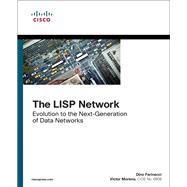In an era of ubiquitous clouds, virtualization, mobility, and the Internet of Things, information and resources must be accessible anytime, from anywhere. Connectivity to devices and workloads must be seamless even when people move: location must be fully independent of device identity.
The LISP protocol makes all this possible. LISP is address-family agnostic, so it can encapsulate any protocol within another, and route across virtually any network. LISP applications include very-large-scale virtualization for WANs and multi-tenant data centers; host mobility and location services across data centers; advanced mobile networks; ad-hoc networks; IPv6 enablement, seamless site multi-homing; workload mobility; cellular mobility; multicast and traffic engineering, and more.
The LISP Network is the first comprehensive, in-depth guide to LISP concepts, architecture, techniques, and applications. Co-authored by LISP co-creator Dino Farinacci and two pioneering developers of Cisco's LISP implementation, this guide will help you plan and implement LISP in any data center, WAN edge, or service provider core network. Largely implementation-agnostic, this book offers actionable answers to questions such as:
- What problems does LISP address, and how does it address them?
- How does LISP work?
- What are LISP's applications, and how do you architect LISP solutions for each application?
- How does LISP fit with SDN, IoT, and IPv6?
- What is LISP's future?
The LISP Network concludes with detailed deployment case studies of several LISP applications, each drawn from the authors' pioneering experience.








